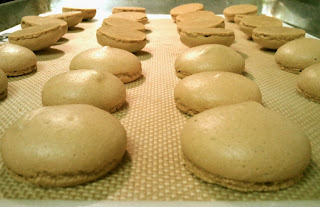Macarons are kind of like that. Yes, it did take me many attempts to get the technique down, but at the end of the day, it's nothing more than making a stiff meringue, deflating it by folding in a sugar/almond flour mixture, and baking it on a lower-than-average temperature to encourage the meringue to rise slightly. Give macarons a try; they really aren't that hard.
I've seen so many posts about French Macarons, and they all involve tutorials, precautions, extra steps, weight measurements, and much more, but my attempts were a bit different. First, I used a volumetric recipe for ease. After getting used to the amounts, the process became more about the technique of folding the meringue than aging my egg whites, weighing each ingredient precisely, or anything else. Before I go into more detail, here were two incredibly helpful guides I found:
I stumbled across this helpful video tutorial from Entertaining with Beth, and it really gave me a good idea of what the macaron batter should look like.
This troubleshooting guide from Food Nouveau helped me to figure out where I was going wrong when my macarons, for example, came out of the oven with hollow, cracked shells.
In short, there are a few steps that are necessary to master and/or gave me particular trouble. Honestly though, it just took a lot of practice (seven - eight batches, to be precise):
- Whipping eggwhites to soft peaks, adding superfine sugar, and continuing to beat until stiff peaks form (and knowing the difference between soft, medium, and stiff peaks).
- Folding almond flour and confectioner's sugar into the meringue and deflating it enough to create an oozey, lava-like batter without it becoming too thin.
- Baking the macarons properly is also important. My oven overheats, so while many recipes have you bake the macarons at 325 degrees F, I bake mine at 305 degrees, and I used two baking sheets stacked on one another.
3/4 cup ground almonds or almond meal
1 cup confectioner's sugar
2 extra large egg whites, room temperature
1/4 cup superfine sugar
gel-based food dye
flavoring (optional: 1/2-1 tsp vanilla, almond, or peppermint extracts or citrus zest)
Prepare two baking sheets by lining them with parchment paper. Prep a pastry bag with a wide, round tip.
Place ground almonds in the bowl of a food processor and process for 30 seconds. Add the powdered sugar and process for 30 seconds - 1 minute. Stir the mixture to loosen and process for an additional minute to ensure mixture is finely ground, almost powdery. Sift this powder into a separate bowl and discard any left over solids.
In the bowl of an electric mixer, beat the egg whites until they hold a soft peak. With the mixer running, gradually add the superfine sugar until a thick, glossy, stiff meringue is formed. I usually allow a minute to incorporate the sugar and it typically takes at least a couple more minutes for the meringue to stiffen. At this stage, add in any dyes or flavorings.
Using a spatula, fold the almond mixture into the meringue in two additions. When all of the dry ingredients are incorporated, stir gently until the mixture is shiny and falls back on itself in thick, again lava-like, ribbons.
Pour the batter into the prepared pastry bag and pipe into mounds of equal size on the parchment paper. I eye-balled the size, but aimed for quarter-to-half-dollar-sized rounds. Tap the baking sheets on the counter to remove any air bubbles. Let these sit at room temperature for 20 - 40 minutes. The goal is to form a tacky skin on top of the macaron. You should be able to touch the top lightly without it being sticky.
Preheat the oven to 305 degrees F. Bake macarons for 15 - 20 minutes. Touch the tops of the macaron to test: they should be solid cookies and should not wriggle on their "feet." While you can immediately remove the parchment from the baking sheet, cool the macarons completely before removing them from the parchment.
Now comes the fun part that doesn't involve any craziness: the filling. As a general rule, because the macarons are so sweet, I prefer tart/strong-flavored fillings. A good chocolate ganache filling, for example...
Chocolate Ganache
4oz chocolate, chopped
1/4 cup heavy cream
1/2 - 1 tbsp flavoring (amaretto, vanilla, coffee liqeuer, etc)
Combine ingredients in a glass bowl set over a medium pot of simmering water. Stir until the chocolate melts, and let it cool for 10 minutes before filling macarons.













